Numerical Analysis of Bifacial Photovoltaic Systems Under Different Snow Climatic Conditions
Abstract
1. Introduction
2. Materials and Methods
3. Results and Discussion
3.1. Performance Analyses of Monofacial and Bifacial Photovoltaic Modules
3.2. Performance Analysis of Snow Conditions
- Approximately 0.5 when the snow thickness is 1–2 cm;
- Approximately 0.6 when the snow thickness is 2–3 cm;
- Approximately 0.7 when the snow thickness is 3–4 cm;
- Approximately 0.8 when the snow thickness is 4–5 cm;
- Above 0.85 when the snow thickness is more than 10 cm.
- Eastern Anatolia (Erzurum, Kars, Ağrı): 0.70–0.90
- o
- Cold and dry snow has a higher albedo value (0.85–0.95).
- o
- Since the snow cover stays for a long time, the albedo may decrease over time due to aging (0.70–0.80).
- o
- Since the region has less industry and air pollution, the purity of the snow may be higher.
- Central Anatolia (Ankara, Sivas, Eskişehir): 0.50–0.75
- o
- In Central Anatolia, melting and refreezing are more common in winter.
- o
- The aging process of snow accelerates, which decreases the albedo value.
- o
- Snow can be polluted more quickly due to industrial and traffic emissions, and the albedo can drop to 0.50.
- Black Sea (Kastamonu, Gümüşhane, Bolu): 0.40–0.65
- o
- Due to high humidity and temperature fluctuations in the Black Sea region, snow is usually wet and heavy.
- o
- Wet snow has a low albedo value (0.40–0.55).
- o
- Due to frequent precipitation in the region, the snow surface is usually not clean, which causes the albedo to remain low.
- Marmara (Istanbul, Bursa, Kocaeli): 0.35–0.60
- o
- Due to the impact of industry and urbanization, the snow darkens faster due to air pollution.
- o
- In and around Istanbul, snow cover is polluted within a short time, and albedo can decrease rapidly.
- Aegean and Mediterranean (Afyon, Isparta, Antalya): 0.25–0.50
- o
- Snow cover is short-lived and melts quickly, so it is not possible to keep the snow clean and shiny all the time.
- o
- Usually, when there is a thin layer of snow, the albedo is low due to the effect of the ground.
- Southeastern Anatolia (Diyarbakır, Gaziantep, Şanlıurfa): 0.20–0.45
- o
- Snowfall is very low and usually remains as a thin layer.
- o
- Since snow mixes with soil and pollution within a short time, albedo decreases rapidly.
4. Conclusions
Author Contributions
Funding
Institutional Review Board Statement
Informed Consent Statement
Data Availability Statement
Conflicts of Interest
Abbreviations
| PV | Photovoltaic |
| MGM | Turkish State Meteorological Service |
References
- Bošnjaković, M. Advance of Sustainable Energy Materials: Technology Trends for Silicon-Based Photovoltaic Cells. Sustainability 2024, 16, 7962. [Google Scholar] [CrossRef]
- Ahmed, E.M.; Aly, M.; Mostafa, M.; Rezk, H.; Alnuman, H.; Alhosaini, W. An Accurate Model for Bifacial Photovoltaic Panels. Sustainability 2022, 15, 509. [Google Scholar] [CrossRef]
- Hayibo, K.S.; Petsiuk, A.; Mayville, P.; Brown, L.; Pearce, J.M. Monofacial vs bifacial solar photovoltaic systems in snowy environments. Renew. Energy 2022, 193, 657–668. [Google Scholar] [CrossRef]
- Frimannslund, I.; Thiis, T.; Ferreira, A.D.; Thorud, B. Impact of solar power plant design parameters on snowdrift accumulation and energy yield. Cold Reg. Sci. Technol. 2022, 201, 103613. [Google Scholar] [CrossRef]
- Frimannslund, I.; Thiis, T.; Aalberg, A.; Thorud, B. Polar solar power plants–Investigating the potential and the design challenges. Sol. Energy 2021, 224, 35–42. [Google Scholar] [CrossRef]
- Russell, A.C.; Valdivia, C.E.; Haysom, J.E.; Hinzer, K. Impact of snow depth on single-axis tracked bifacial photovoltaic system performance. In Proceedings of the 2022 IEEE 49th Photovoltaics Specialists Conference (PVSC), Philadelphia, PA, USA, 5–10 June 2022; pp. 1–4. [Google Scholar]
- Riise, H.N.; Øgaard, M.; Zhu, J.; You, C.C.; Andersson, F.; Bønsnæs, T.; Young, J.; Foss, S.E. Performance analysis of a BAPV bifacial system in Norway. In Proceedings of the 2022 IEEE 49th Photovoltaics Specialists Conference (PVSC), Fort Lauderdale, FL, USA , 20–25 June 2021; pp. 1304–1308. [Google Scholar]
- Molin, E.; Stridh, B.; Molin, A.; Wäckelgård, E. Experimental yield study of bifacial PV modules in nordic conditions. IEEE J. Photovolt. 2018, 8, 1457–1463. [Google Scholar] [CrossRef]
- Singh, A.; Jones, D. Snow shedding properties of bifacial PV panels. In Proceedings of the 2022 IEEE 49th Photovoltaics Specialists Conference (PVSC), Philadelphia, PA, USA, 5–10 June 2022; pp. 646–648. [Google Scholar]
- D’Alessandro, V.; Daliento, S.; Dhimish, M.; Guerriero, P. Albedo reflection modeling in bifacial photovoltaic modules. Solar 2024, 4, 660–673. [Google Scholar] [CrossRef]
- Ghafiri, S.; Darnon, M.; Davigny, A.; Trovão, J.P.F.; Abbes, D. A comprehensive performance evaluation of bifacial photovoltaic modules: Insights from a year-long experimental study conducted in the Canadian climate. EPJ Photovolt. 2024, 15, 28. [Google Scholar] [CrossRef]
- Riedel-Lyngskær, N.; Ribaconka, M.; Pó, M.; Thorseth, A.; Thorsteinsson, S.; Dam-Hansen, C.; Jakobsen, M.L. The effect of spectral albedo in bifacial photovoltaic performance. Sol. Energy 2022, 231, 921–935. [Google Scholar] [CrossRef]
- Asgharzadeh, A.; Marion, B.; Deline, C.; Hansen, C.; Stein, J.S.; Toor, F. A sensitivity study of the impact of installation parameters and system configuration on the performance of bifacial PV arrays. IEEE J. Photovolt. 2018, 8, 798–805. [Google Scholar] [CrossRef]
- Alam, M.; Gul, M.S.; Muneer, T. Performance analysis and comparison between bifacial and monofacial solar photovoltaic at various ground albedo conditions. Renew. Energy Focus 2023, 44, 295–316. [Google Scholar] [CrossRef]
- Wang, W.; Yang, K.; Zhao, L.; Zheng, Z.; Lu, H.; Mamtimin, A.; Ding, B.; Li, X.; Zhao, L.; Li, H. Characterizing surface albedo of shallow fresh snow and its importance for snow ablation on the interior of the Tibetan Plateau. J. Hydrometeorol. 2020, 21, 815–827. [Google Scholar] [CrossRef]
- Miao, X.; Guo, W.; Li, W.; Cao, Y.; Ge, J.; Qiu, B. Instant response of Tibetan Plateau surface albedo to snow coverage and depth in snow season. Geophys. Res. Lett. 2024, 51, e2023GL108010. [Google Scholar] [CrossRef]
- Grenfell, T.C.; Warren, S.G.; Mullen, P.C. Reflection of solar radiation by the Antarctic snow surface at ultraviolet, visible, and near-infrared wavelengths. J. Geophys. Res. Atmos. 1994, 99, 18669–18684. [Google Scholar] [CrossRef]
- Lee, W.Y.; Gim, H.-J.; Park, S.K. Parameterizations of snow cover, snow albedo and snow density in land surface models: A comparative review. Asia-Pac. J. Atmos. Sci. 2024, 60, 185–210. [Google Scholar] [CrossRef]
- Best, M.J.; Pryor, M.; Clark, D.; Rooney, G.G.; Essery, R.; Ménard, C.; Edwards, J.; Hendry, M.; Porson, A.; Gedney, N. The Joint UK Land Environment Simulator (JULES), model description–Part 1: Energy and Water Fluxes. Geosci. Model Dev. 2011, 4, 677–699. [Google Scholar] [CrossRef]
- Dutra, E.; Balsamo, G.; Viterbo, P.; Miranda, P.; Beljaars, A.; Schär, C.; Elder, K. New Snow Scheme in HTESSEL: Description and Offline Validation; ECMWF: Reading, UK, 2009. [Google Scholar]
- Dincer, F.; Ozer, E. Assessing the potential of a rooftop grid-connected photovoltaic system for Gaziantep Islamic Science and Technology University/Turkey. Jordan J. Electr. Eng. 2023, 9, 150. [Google Scholar] [CrossRef]
- Dinçer, F. Overview of the photovoltaic technology status and perspective in Turkey. Renew. Sustain. Energy Rev. 2011, 15, 3768–3779. [Google Scholar] [CrossRef]
- GEPA-Solar Energy Potential Atlas. 2025. Available online: https://gepa.enerji.gov.tr/MyCalculator/ (accessed on 30 January 2025).
- MGM-Turkish State Meteorological Service. 2025. Available online: https://www.mgm.gov.tr/veridegerlendirme/il-ve-ilceler-istatistik.aspx?m=ERZURUM (accessed on 30 January 2025).
- King, D.L.; Kratochvil, J.A.; Boyson, W.E. Photovoltaic Array Performance Model; Citeseer: University Park, PA, USA, 2004; Volume 8. [Google Scholar]
- Faiman, D. Assessing the outdoor operating temperature of photovoltaic modules. Prog. Photovolt. Res. Appl. 2008, 16, 307–315. [Google Scholar] [CrossRef]
- Hansen, C.; Riley, D.; Deline, C.; Toor, F.; Stein, J. A Detailed Performance Model for Bifacial PV Modules; Sandia National Lab. (SNL-NM): Albuquerque, NM, USA, 2017. [Google Scholar]
- Osama, A.; Tina, G.M.; Gagliano, A. Thermal models for mono/bifacial modules in ground/floating photovoltaic systems: A review. Renew. Sustain. Energy Rev. 2025, 216, 115627. [Google Scholar] [CrossRef]
- Akhsassi, M.; El Fathi, A.; Erraissi, N.; Aarich, N.; Bennouna, A.; Raoufi, M.; Outzourhit, A. Experimental investigation and modeling of the thermal behavior of a solar PV module. Sol. Energy Mater. Sol. Cells 2018, 180, 271–279. [Google Scholar] [CrossRef]
- Riley, D.; Hansen, C.; Stein, J.; Lave, M.; Kallickal, J.; Marion, B.; Toor, F. A performance model for bifacial PV modules. In Proceedings of the 2017 IEEE 44th Photovoltaic Specialist Conference (PVSC), Washington, DC, USA, 25–30 June 2017; pp. 3348–3353. [Google Scholar]
- Ait Ali, A.; Ouhassan, Y.; Abouyaakoub, M.; Chahboun, M.; Hihi, H. The Impact of Desert Regions on Solar Energy Production with the Evaluation of Groundwater for Maintenance: A Case Study in Morocco. Sustainability 2024, 16, 5476. [Google Scholar] [CrossRef]
- Bugeja, R.; Mule’Stagno, L.; Niarchos, I. Full-scale design, implementation and testing of an innovative photovoltaic cooling system (IPCoSy). Sustainability 2023, 15, 16900. [Google Scholar] [CrossRef]
- Benghanem, M.; Haddad, S.; Alzahrani, A.; Mellit, A.; Almohamadi, H.; Khushaim, M.; Aida, M.S. Evaluation of the performance of polycrystalline and monocrystalline PV technologies in a hot and arid region: An experimental analysis. Sustainability 2023, 15, 14831. [Google Scholar] [CrossRef]
- Gulkowski, S.; Zdyb, A.; Dragan, P. Experimental efficiency analysis of a photovoltaic system with different module technologies under temperate climate conditions. Appl. Sci. 2019, 9, 141. [Google Scholar] [CrossRef]
- Zdyb, A.; Sobczyński, D. An Assessment of a Photovoltaic System’s Performance Based on the Measurements of Electric Parameters under Changing External Conditions. Energies 2024, 17, 2197. [Google Scholar] [CrossRef]
- Bamisile, O.; Acen, C.; Cai, D.; Huang, Q.; Staffell, I. The environmental factors affecting solar photovoltaic output. Renew. Sustain. Energy Rev. 2025, 208, 115073. [Google Scholar] [CrossRef]
- Bakirci, K. Correlations for optimum tilt angles of solar collectors: A case study in Erzurum, Turkey. Energy Sources Part A Recovery Util. Environ. Eff. 2012, 34, 983–993. [Google Scholar] [CrossRef]
- PVsyst, Albedo Coefficient. 2025. Available online: https://www.pvsyst.com/help-pvsyst7/albedo.htm (accessed on 30 January 2025).
- Stein, J.; Reise, C.; Castro, J.B.; Friesen, G.; Maugeri, G.; Urrejola, E.; Ranta, S. Bifacial Photovoltaic Modules and Systems: Experience and Results from International Research and Pilot Applications; Sandia National Lab. (SNL-NM): Albuquerque, NM, USA, 2021. [Google Scholar]
- MGM-Turkish State Meteorological Service. 2025. Available online: https://www.mgm.gov.tr/FILES/resmi-istatistikler/parametreAnalizi/2024-kar-ortulu-gunler.pdf (accessed on 30 January 2025).
- Heidari, N.; Gwamuri, J.; Townsend, T.; Pearce, J.M. Impact of snow and ground interference on photovoltaic electric system performance. IEEE J. Photovolt. 2015, 5, 1680–1685. [Google Scholar] [CrossRef]
- Baldus-Jeursen, C.; Petsiuk, A.L.; Rheault, S.-A.; Pelland, S.; Côté, A.; Poissant, Y.; Pearce, J.M. Snow losses for photovoltaic systems: Validating the marion and townsend models. IEEE J. Photovolt. 2023, 13, 610–620. [Google Scholar] [CrossRef]
- Brench, B.L. Snow-Covering Effects on the Power Output of Solar Photovoltaic Arrays; Massachusetts Institute of Technology (MIT): Lexington, MA, USA, 1979. [Google Scholar]
- Van Noord, M.; Landelius, T.; Andersson, S. Snow-induced PV loss modeling using production-data inferred PV system models. Energies 2021, 14, 1574. [Google Scholar] [CrossRef]
- Cooper, E.C.; Burnham, L.; Braid, J.L. Photovoltaic inverter-based quantification of snow conditions and power loss. EPJ Photovolt. 2024, 15, 6. [Google Scholar] [CrossRef]
- Abou Yassine, A.H.; Khoshbakhtnejad, E.; Sojoudi, H. Economics of snow accumulation on photovoltaic modules. Energies 2024, 17, 2962. [Google Scholar] [CrossRef]
- Walker, H.; Lockhart, E.; Desai, J.; Ardani, K.; Klise, G.; Lavrova, O.; Tansy, T.; Deot, J.; Fox, B.; Pochiraju, A. Model of Operation-and-Maintenance Costs for Photovoltaic Systems; National Renewable Energy Lab. (NREL): Golden, CO, USA, 2020. [Google Scholar]
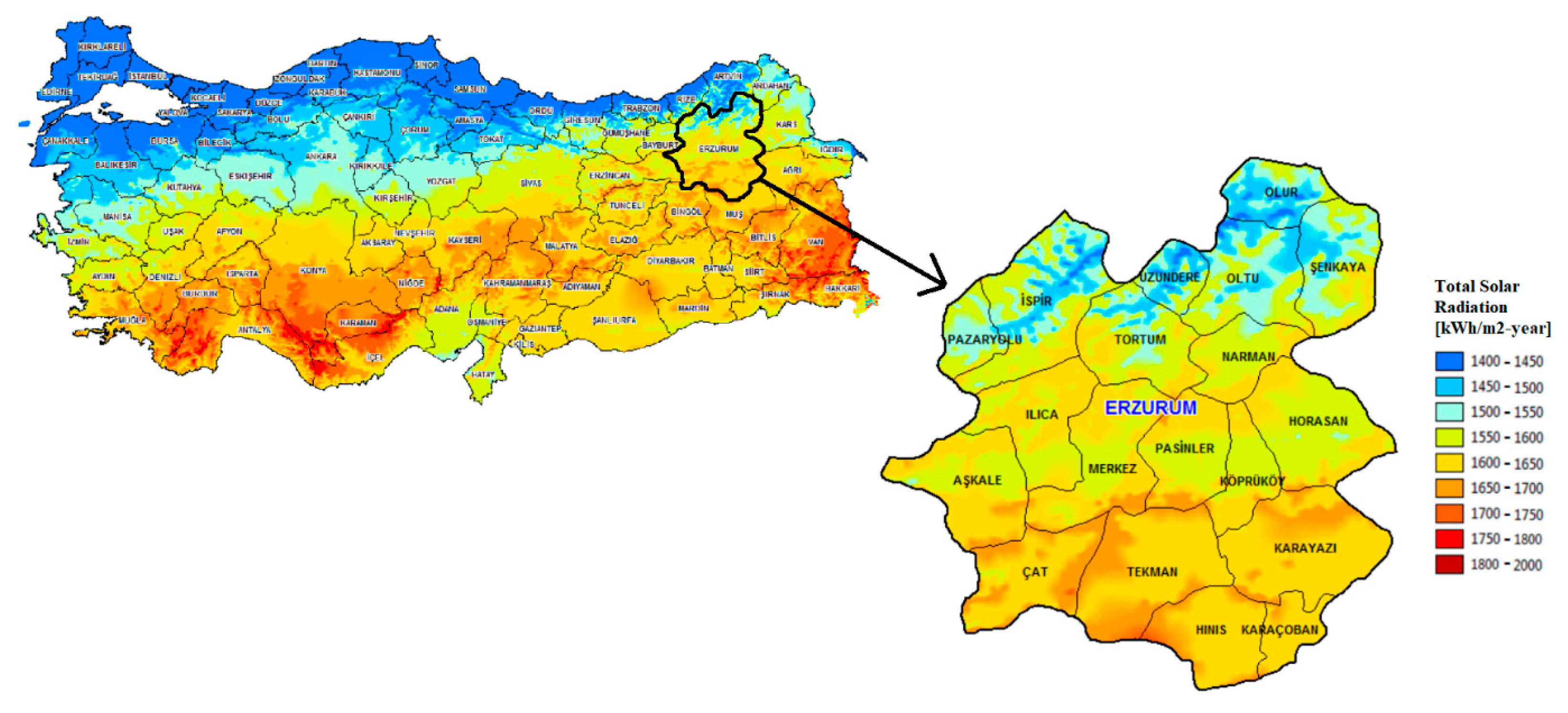



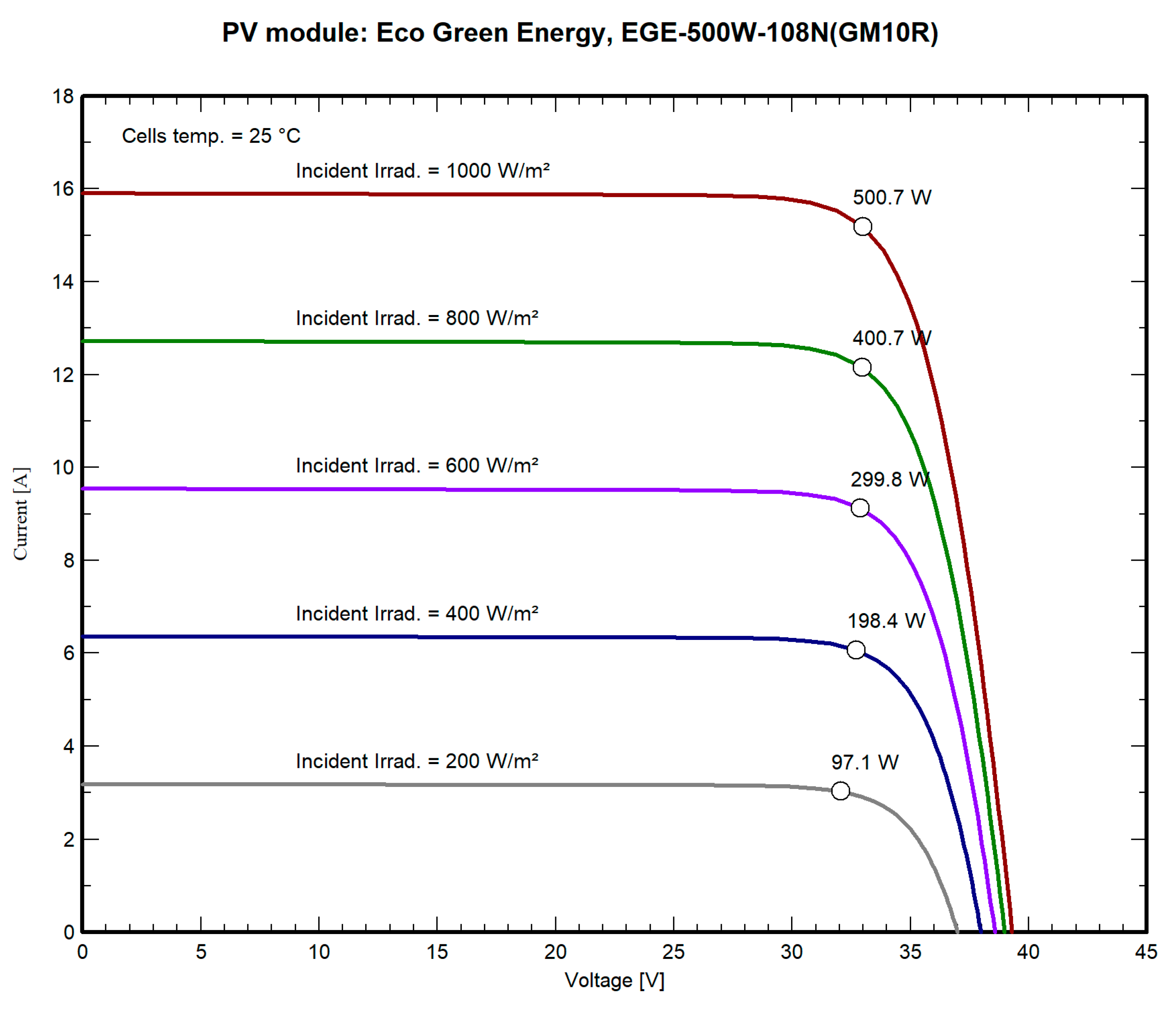

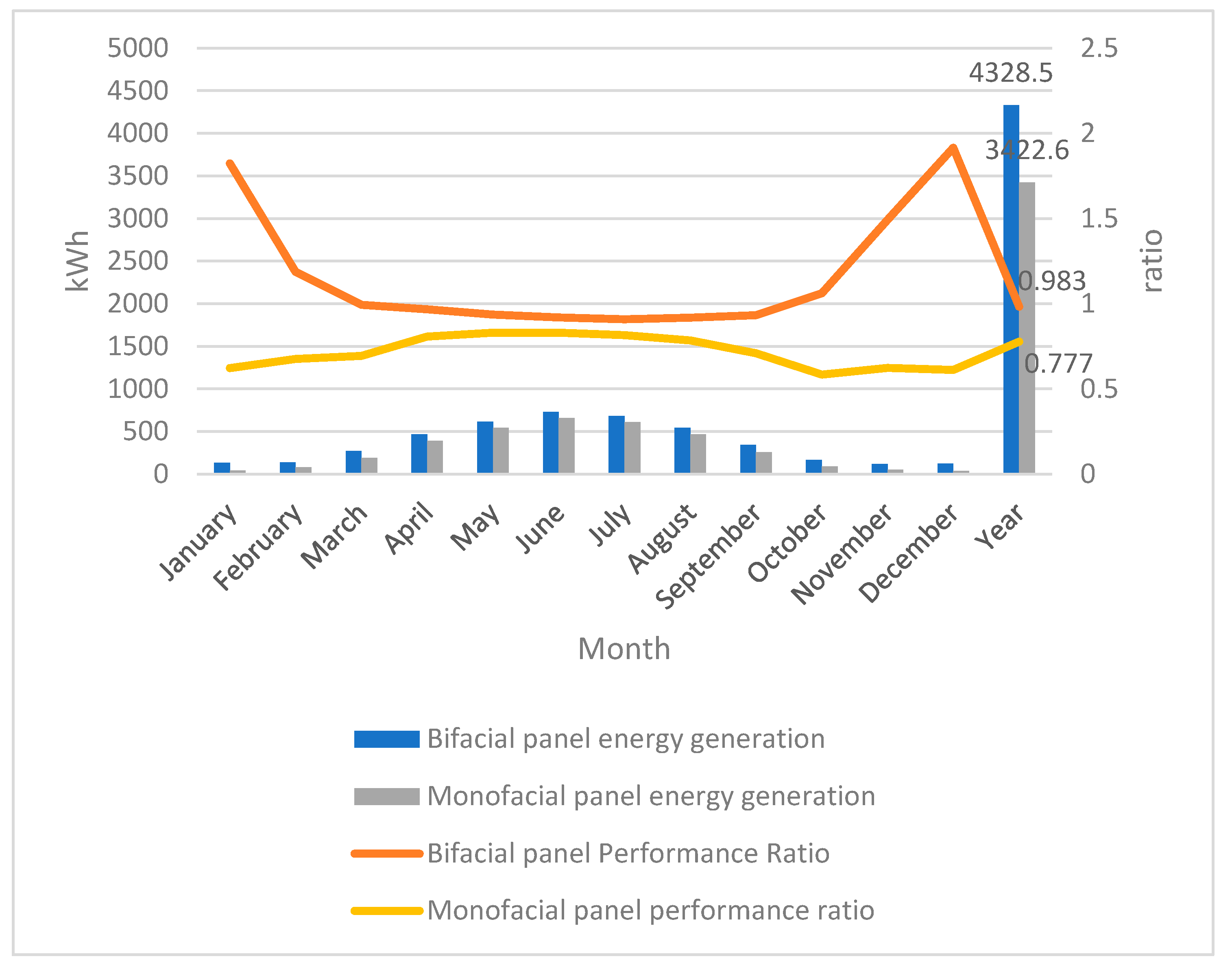
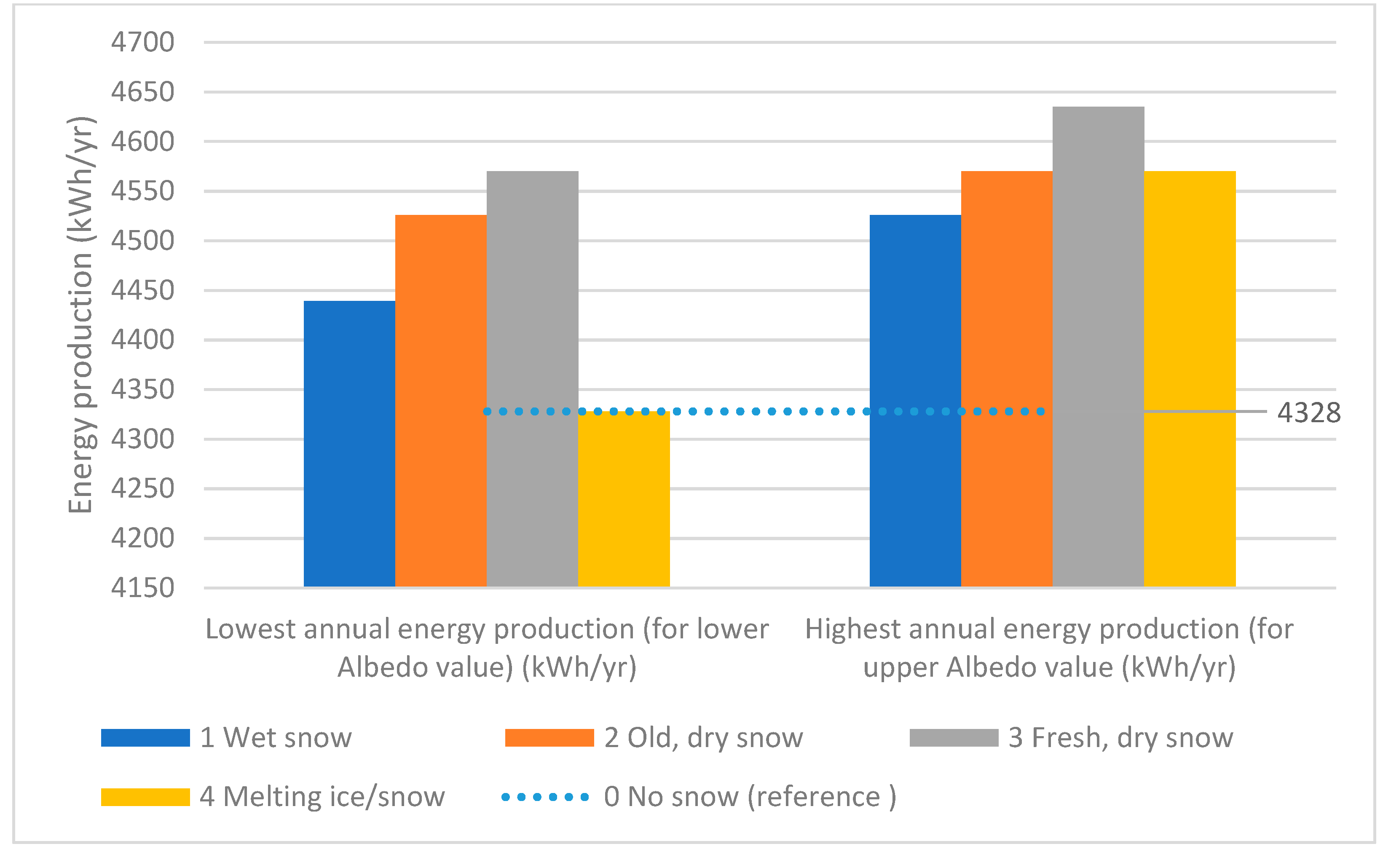

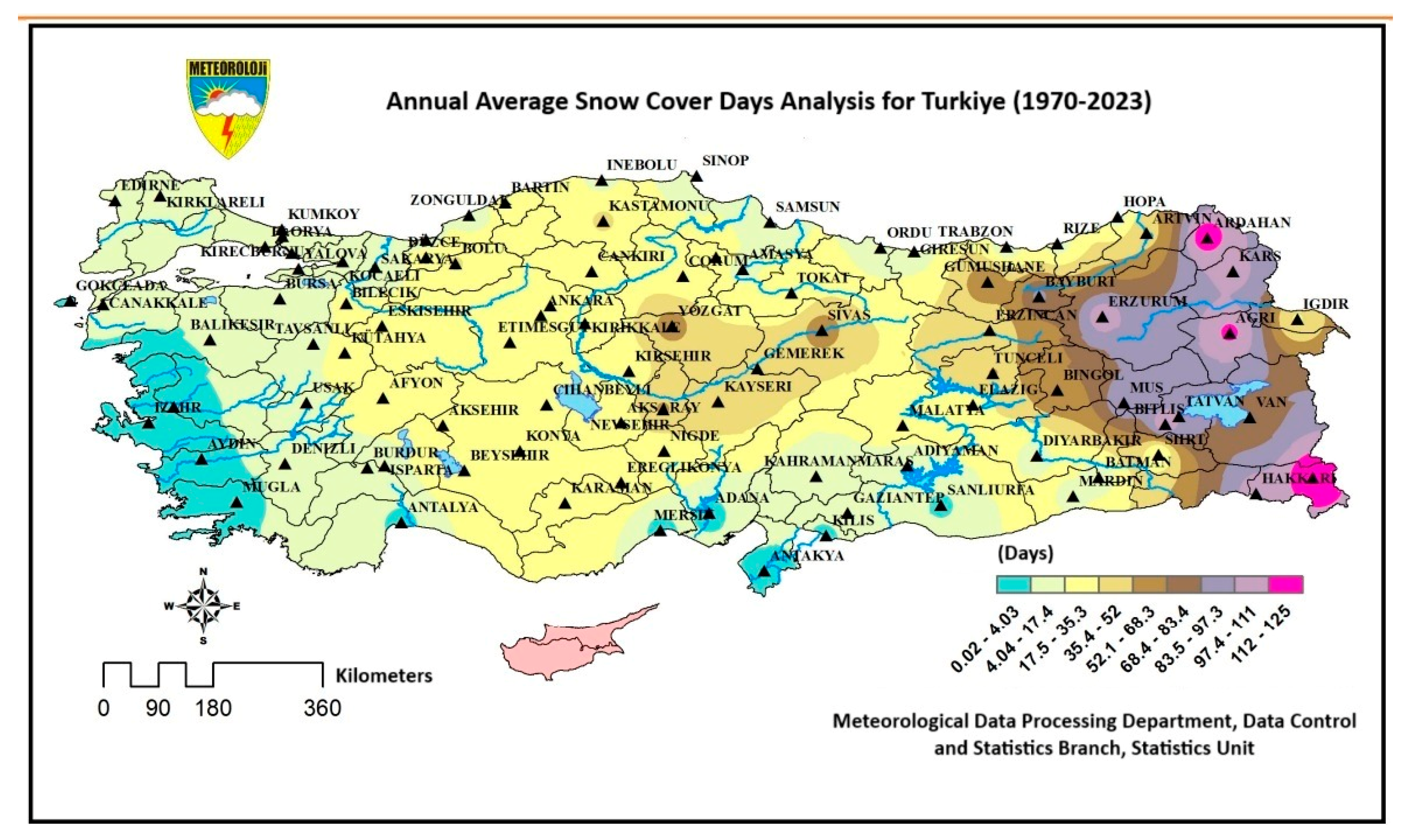
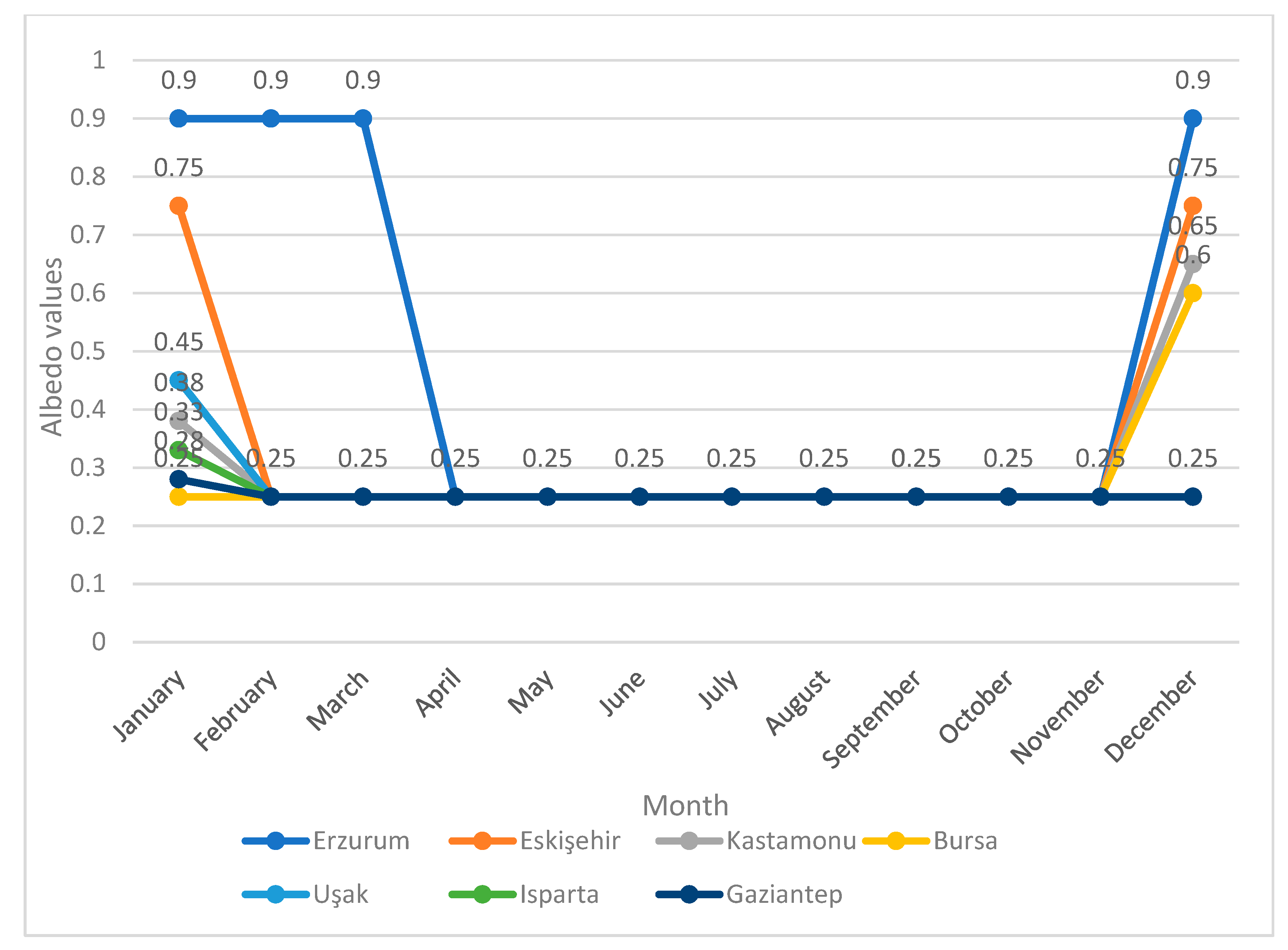

| Jan. | Feb. | March | Apr. | May | June | July | August | Sept. | Oct. | Nov. | Dec. | Annual | |
|---|---|---|---|---|---|---|---|---|---|---|---|---|---|
| Average Temp. (°C) | −9 | −7.6 | −2.3 | 5.4 | 10.7 | 14.9 | 19.2 | 19.5 | 14.8 | 8.2 | 1.2 | −5.8 | 5.8 |
| Average Sunshine Duration (hours) | 3.4 | 4.5 | 5.2 | 6.4 | 7.9 | 10.2 | 11.2 | 10.7 | 9.1 | 6.9 | 4.9 | 3.2 | 7.0 |
| Average Number of Rainy Days | 11.23 | 10.98 | 12.54 | 13.7 | 16.04 | 10.98 | 6.75 | 5.2 | 5.14 | 9.44 | 9.19 | 10.59 | 121.8 |
| Average Monthly Total Precipitation (mm) | 21.5 | 25.4 | 35.5 | 54.6 | 73.1 | 48.5 | 28.6 | 17.6 | 24.1 | 46.7 | 33.3 | 22 | 430.9 |
| Maximum Temp. (°C) | 10.4 | 10.6 | 21.4 | 26.5 | 29.6 | 32.3 | 35.6 | 36.5 | 33.3 | 27 | 20.7 | 14 | 36.5 |
| Minimum Temp. (°C) | −36 | −37 | −33.2 | −22.4 | −7.1 | −5.6 | −1.8 | −1.1 | −6.8 | −14.1 | −34.3 | −37.2 | −37.2 |
| Month | Global Horz. Irradiation (kWh/m2/month) | Diffuse Horz. Irradiation (kWh/m2/month) | Temp. (°C) | Wind Speed (m/s) | Linke Turbidity | Relative Humidity (%) |
|---|---|---|---|---|---|---|
| January | 79.1 | 23.2 | −11.1 | 2.2 | 2.677 | 84.2 |
| February | 93.1 | 35.8 | −8.9 | 2.39 | 3.034 | 84.9 |
| March | 149.2 | 44.6 | −1.2 | 3.4 | 3.529 | 74.3 |
| April | 186.3 | 48.3 | 5.5 | 3.6 | 4.223 | 66.6 |
| May | 208.4 | 50.5 | 11.3 | 3.3 | 3.659 | 65.2 |
| June | 237.6 | 60.5 | 15 | 3.2 | 3.169 | 57.1 |
| July | 230 | 57.2 | 19.7 | 3.7 | 3.226 | 51 |
| August | 215.9 | 52.4 | 19.3 | 3.89 | 3.211 | 44.8 |
| September | 174.2 | 42.3 | 14.4 | 3.1 | 2.86 | 49.1 |
| October | 124.7 | 35 | 8 | 2.9 | 3.204 | 65.6 |
| November | 83.6 | 25.8 | 0 | 2.59 | 2.763 | 74.4 |
| December | 68.2 | 23 | −7.5 | 2.2 | 2.638 | 83.1 |
| Year | 1850.3 | 520.9 | 5.4 | 3 | 3.183 | 66.7 |
| Parameter | Value |
|---|---|
| Manufacturer | Layer |
| Model | GC-204 |
| Minimum MPP Voltage | 100 V |
| Maximum MPP Voltage | 430 V |
| Nominal MPP Voltage | 400 V |
| Absolute Max. PV Voltage | 500 V |
| Min. Voltage for Pnom | 100 V |
| Maximum Input Current | 21.1 A |
| Power Threshold | 0 W |
| Grid Frequency | 50 Hz/60 Hz |
| Grid Voltage | 230 V |
| Nominal AC Power | 4.00 kW |
| Maximum AC Power | 4.20 kW |
| Nominal AC Current | 17.40 A |
| Maximum AC Current | 18.00 A |
| Nominal PV Power | 4.50 kW |
| Maximum PV Current | 21.00 A |
| Maximum Efficiency | 96.00% |
| Snow Type | Albedo Lower Value | Albedo Upper Value |
|---|---|---|
| Wet snow | 0.50 | 0.70 |
| Old, dry snow | 0.70 | 0.80 |
| Fresh, dry snow | 0.80 | 0.95 |
| Melting ice/snow | 0.25 | 0.80 |
| Properties | Bifacial Panel | Monofacial Panel |
|---|---|---|
| Model | EGE-500W-108N(GM10R) | EGE-500W-108N(M10R) |
| Nominal power | 500 Wp | 500 Wp |
| Tecnology | Si-mono | Si-mono |
| Short-circuit current (Isc) | 15.9 A | 15.9 A |
| Open circuit (Voc) | 39.30 V | 39.30 V |
| Module length | 1961 mm | 1961 mm |
| Module width | 1134 mm | 1134 mm |
| Weight | 28.50 kg | 25.00 kg |
| Number cells in series | 54·2 | 54·2 |
| Bifacial Panel | Monofacial Panel | |||
|---|---|---|---|---|
| Month | Energy Generation (kWh) | Performance Ratio | Energy Generation (kWh) | Performance Ratio |
| January | 131.0 | 1.823 | 44.7 | 0.622 |
| February | 139.9 | 1.187 | 79.6 | 0.676 |
| March | 269.7 | 0.993 | 188.5 | 0.694 |
| April | 466.9 | 0.967 | 389.5 | 0.807 |
| May | 614.2 | 0.936 | 544.3 | 0.830 |
| June | 730.9 | 0.920 | 660.2 | 0.831 |
| July | 680.5 | 0.909 | 610.2 | 0.816 |
| August | 545.2 | 0.918 | 465.9 | 0.785 |
| September | 340.9 | 0.933 | 259.0 | 0.709 |
| October | 165.4 | 1.061 | 91.0 | 0.584 |
| November | 119.0 | 1.492 | 49.7 | 0.623 |
| December | 124.9 | 1.915 | 39.9 | 0.612 |
| Year | 4328.5 | 0.983 | 3422.6 | 0.777 |
| Condition | Snow Type | Lowest Annual Energy Production (for Lower Albedo Value) (kWh/yr.) | Highest Annual Energy Production (for Upper Albedo Value (kWh/yr.) |
|---|---|---|---|
| 0 | No snow | 4328 (reference) | 4328 (reference) |
| 1 | Wet snow | 4439 | 4526 |
| 2 | Old, dry snow | 4526 | 4570 |
| 3 | Fresh, dry snow | 4570 | 4635 |
| 4 | Melting ice/snow | 4328 | 4570 |
| Condition | Snow Depth | Albedo Value | Annual Energy Production (kWh/yr.) |
|---|---|---|---|
| 1 | 1–2 cm | 0.5 | 4439 |
| 2 | 2–3 cm | 0.6 | 4483 |
| 3 | 3–4 cm | 0.7 | 4526 |
| 4 | 4–5 cm | 0.8 | 4570 |
| 5 | 5–10 cm | 0.82 | 4579 |
| 6 | 10 cm–upper | 0.88 | 4605 |
| Region | Sample Provinces | Snow Cover Duration (Day/Year) | General Albedo Value |
|---|---|---|---|
| Eastern Anatolia | Erzurum, Kars, Ağrı, Van | 80–120 days | 0.70–0.90 |
| Central Anatolia | Ankara, Eskişehir, Sivas | 30–60 days | 0.50–0.75 |
| Black Sea | Kastamonu, Gümüşhane, Bolu | 10–40 days | 0.40–0.65 |
| Marmara | İstanbul, Bursa, Kocaeli | 5–30 days | 0.35–0.60 |
| Aegean | Afyon, Uşak, Kütahya | 5–20 days | 0.30–0.55 |
| Mediterranean | Isparta, Burdur, Kahramanmaraş | 0–10 days | 0.25–0.50 |
| Southeastern Anatolia | Diyarbakır, Gaziantep, Şanlıurfa | 0–5 days | 0.20–0.45 |
| Region | Province | Site | Accepted Time Interval for Snow Cover | Accepted Albedo Value | Annual Energy Production (kWh/yr.) |
|---|---|---|---|---|---|
| Eastern Anatolia | Erzurum | Latitude: 39.90° N Longitude: 41.26° E Altitude: 1918 m | December, January, February, and March | 0.9 (Dec, Jan, Feb, and Mar) 0.25 (Other 8 months) | 4799 |
| Central Anatolia | Eskişehir | Latitude: 39.77° N Longitude: 30.51° E Altitude: 789 m | December and January | 0.75 (Dec, Jan) 0.25 (Other 10 months) | 3144 |
| Black Sea | Kastamonu | Latitude: 41.38° N Longitude: 33.78° E Altitude: 795 m | December and January: first 10 days | 0.65 (Dec) 0.38 (Jan) 0.25 (Other 10 months) | 2972 |
| Marmara | Bursa | Latitude: 40.19° N Longitude: 29.06° E Altitude: 252 m | December | 0.6 (Dec) 0.25 (Other 11 months) | 3142 |
| Aegean | Uşak | Latitude: 38.67° N Longitude: 29.40° E Altitude: 913 m | January: first 20 days | 0.45 (Jan) 0.25 (Other 11 months) | 3390 |
| Mediterranean | Isparta | Latitude: 37.78° N Longitude: 30.57° E Altitude: 997 m | January: first 10 days | 0.33 (Jan) 0.25 (Other 11 months) | 3362 |
| Southeastern Anatolia | Gaziantep | Latitude: 37.07° N Longitude: 37.38° E Altitude: 828 m | January: first 5 days | 0.28 (Jan) 0.25 (Other 11 months) | 3647 |
| Study | Location | System Type | Snow/Albedo Parameter | Effect on Energy Yield | Contribution |
|---|---|---|---|---|---|
| Riise et al. [7] | Norway | Fixed Tilt 35° Bifacial | Albedo-enhancing membrane (40–60%), snow | Bifacial gain 17% | Combined effect of artificial albedo and snow contribution |
| Molin et al. [8] | Sweden | Fixed Tilt 40° Bifacial/Vertical E–W | Albedo (snow + ground), snow cover days | Bifacial gain 5–48% | Direct measurement of snow-induced albedo effects |
| Singh & Jones [9] | USA, Utah | Horizontal Bifacial vs. Monofacial | Albedo 75%, snow melting effect | Bifacial modules cleared snow 2–3 days faster → lower energy loss | Snow dynamics and albedo benefit emphasized |
| Ghafiri et al. [11] | Canada | Fixed Tilt 30° Bifacial | Snow depth ≥2 cm, albedo >0.9 | Winter bifacial gain 28.4% | Snow and albedo impact analyzed |
| This Study | Turkey (7 regions) | Fixed Tilt Bifacial | Snow type, snow depth, snow cover duration | Fresh snow ~7% gain; ≥10 cm snow ~4% gain; eastern regions up to 60% higher annual yield | First systematic regional analysis of snow and albedo impacts in a mid-latitude country |
Disclaimer/Publisher’s Note: The statements, opinions and data contained in all publications are solely those of the individual author(s) and contributor(s) and not of MDPI and/or the editor(s). MDPI and/or the editor(s) disclaim responsibility for any injury to people or property resulting from any ideas, methods, instructions or products referred to in the content. |
© 2025 by the authors. Licensee MDPI, Basel, Switzerland. This article is an open access article distributed under the terms and conditions of the Creative Commons Attribution (CC BY) license (https://creativecommons.org/licenses/by/4.0/).
Share and Cite
Dincer, F.; Ozer, E. Numerical Analysis of Bifacial Photovoltaic Systems Under Different Snow Climatic Conditions. Sustainability 2025, 17, 6350. https://doi.org/10.3390/su17146350
Dincer F, Ozer E. Numerical Analysis of Bifacial Photovoltaic Systems Under Different Snow Climatic Conditions. Sustainability. 2025; 17(14):6350. https://doi.org/10.3390/su17146350
Chicago/Turabian StyleDincer, Furkan, and Emre Ozer. 2025. "Numerical Analysis of Bifacial Photovoltaic Systems Under Different Snow Climatic Conditions" Sustainability 17, no. 14: 6350. https://doi.org/10.3390/su17146350
APA StyleDincer, F., & Ozer, E. (2025). Numerical Analysis of Bifacial Photovoltaic Systems Under Different Snow Climatic Conditions. Sustainability, 17(14), 6350. https://doi.org/10.3390/su17146350







